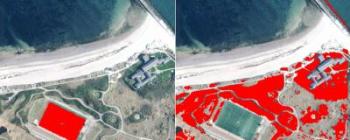Mar 13 2014
Cameras with hyperspectral sensors can observe far more than the human eye. Unlike the retina, which has only three color receptors (red, green and blue), these sensors can generate 130 different color values per pixel. Using this high-grade color resolution, an entire range of different materials can be differentiated impeccably – even if, at first glance, they appear the same to the human eye.
 Artificial turf (left) or real vegetation (right)?: The SpectralFinder recognizes the color spectrum of surfaces in real time. Credit: © Fraunhofer IOSB
Artificial turf (left) or real vegetation (right)?: The SpectralFinder recognizes the color spectrum of surfaces in real time. Credit: © Fraunhofer IOSB
This is because every substance has its own individual color spectrum, irrespective of how its surface reflects the light hitting it. This hyperspectral technology can be used anyplace where surfaces have to be examined with a fine-toothed comb: for example, in the search for mineral resources, quality control in the production process, or food manufacturing as well as environmental monitoring from the air. The systems that are currently available, however, can only process the information very slowly. Because massive volumes of data are accumulated from the analyses. Indeed, hyperspectral cameras – which can record video images at the same time – may even accumulate up to one gigabyte per minute. All too often, the analysis lags behind, or is just plain impossible.
The Fraunhofer Institute of Optronics, System Technologies and Image Exploitation IOSB is unveiling the SpectralFinder – a software application that can record vast amounts of hyperspectral data on a mobile platform and analyze them in real time – at this year's CeBIT in Hannover from 10 to 14 March (Hall 9, Booth E40). It's an essential requirement if, for example, you want to apply it to assembly-line production. "Our expertise lies in handling large quantities of data, the real-time capability, and the intuitive ease-of-operation," explains Dr. Wolfgang Middelmann, who heads the corresponding Image Interpretation Research Group at IOSB. The technology generates a 130-channel image of the surface based on the various color spectra that the camera records. "Think of it like a map, where lakes, cities, streets, fields and mountains are plotted differently using various colors," explains Caroline Stolka, a research group staff member. If the user clicks an image area on the monitor, an algorithm immediately displays where similar surfaces can be found in the live images. This is accomplished when the software compares the 130 color values within the image area with the remaining image pixels; it then displays those surfaces which have the best corresponding color values. "It also operates when the camera or the object is moving. The materials can even be classified while data is still being collected," Stolka says.
Compact system for environmental protection
The technology is available as a prototype. Researchers have successfully tested potential application scenarios in the laboratory. The entire system consists of a hyperspectral camera and a connected computer that has SpectralFinder installed on it. The compact technology can be manually operated with ease. "This manner of detecting and classifying materials on a mobile basis provides a great benefit to the various fields – take environmental monitoring, for example, on the ground and from the air," says Mid delmann. The scientists have programmed the software in such manner that the recorded color spectra can also be compared with an attached materials database. The system operates from a great distance – such as when taking pictures from the air. This technology could help keep landscapes clean by quickly exposing pollution, by delivering important information about health conditions or pest infestation to land and forest management authorities, or by supporting water pollution control and identifying at-risk areas when dikes or levees are at peril of collapse.
Visitors to the CeBIT joint exhibition booth of the Fraunhofer-Gesellschaft can test the SpectralFinder by moving the camera in front of a material wall, seeing its live recordings on the monitor and applying the software. Objects from the world of mining can be studied, along with things that play a role in environmental monitoring. The scientists will also be presenting their technology in a virtual laboratory. An initial scenario can also be seen at CeBIT.